
|   |

|   |
Shivapriya School of Dance celebrates silver jubilee - Lalitha Venkat e-mail: lalvenkat@yahoo.com Photos: Srivatsa Shandilya June 30, 2013 Kuchipudi and Bharatanatyam dancer Sanjay Shantaram celebrated 25 years of his dance institution Shivapriya School of Dance with a three day festival Nrityantara (its fourth edition) from June 25 to 27 at Bangalore. The festival showcased the talent of established as well as upcoming artistes. The inaugural function took place at the compact Seva Sadan where the stage was aesthetically designed with a row of diyas bordering the front of the stage. The celebration took off with a spirited Kuchipudi recital by talented dancer SV Gopal Krishna, a disciple of Sanjay Shantaram. He presented a kirtana by Saint Thyagaraja “Bala kanakamaya chela” in Atana raga in which Thyagaraja pleads for blessings and support of Lord Rama, who in his benevolence helped and blessed his many devotees. He laments, “Why do you not bless me and come to my aid?” The uncluttered jewellery, neat costume, leaps and confident footwork impressed the rasikas. The next item was the popular devarnama “Baro Krishnayya.” As a devotee, Kanakadasa pleads with Krishna to play with him by luring him with butter, praising his flute playing and so on. In his announcement, Sanjay Shantaram said that usually Narayana Teertha’s tarangams are performed but nowadays adaptations are being done, and he had specially choreographed “Baro Krishnayya” into a tarangam format concluding with dancing on a brass plate. Gopal Krishna performed with all the verve and vigor typical of a Kuchipudi recital, even doing lip-sync for most of the lines. Kuchipudi’s soft, flowing movements are needed in places and the dancer looked more like he was grabbing little Krishna instead of cajoling and embracing him.  Gopal Krishna 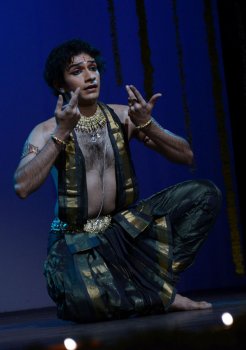 Pavitra Bhat The next performer Pavitra Bhat from Mumbai commenced with a melaprapti combined with alarippu in khanda chapu with Ganapathi Stuti. The dancer exuded confidence in his every move. The Hanuman Chalisa of 40 verses written by Tulsidas in praise of the vayuputra was choreographed by Bhat’s guru Deepak Mazumdar in a varnam format. Nritta, nrithya and abhinaya all shone in the neat 30 minute varnam specially choreographed for the festival. Bhat said that it was a challenge for his guru to transform the religious verses into dance format and the challenge for him as a dancer was that since none of the 40 verses could be cut down, he had to perform continuously with no chance of taking a breather (he anyway never looked out of breath!). The vocal was by P Rama, jathis by the late Guru Kadirvelu, nattuvangam by Deepak Mazumdar. Both Gopal Krishna and Pavitra Bhat did well in executing the ideas of their respective gurus. 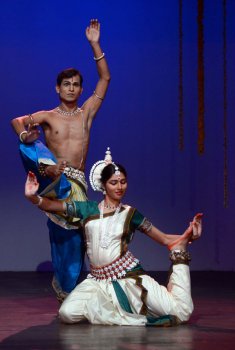 Bishwa Mohan Mohapatra & Soumya Sikta Sahoo The finale was an Odissi duet by Bishwa Mohan Mohapatra from Odisha and Soumya Sikta Sahoo (presently learning under Madhulita Mahapatra). Bishwa Mohan is the first recipient of the Protima Gauri scholarship from Nrityagram in 2009. Divya Kundalam was the invocatory item on Lord Shiva telling the tale of Kamadeva striking Shiva with his arrow and Shiva then reducing Kamadeva into ashes. The choreography was by Guru Gangadhar Pradhan. Pallavi in raag Shankarabharanam was a choreography of Guru Kelucharan Mohapatra. The final item was “Chandana charchita” choreographed by Kelubabu to music by Bhubaneswar Misra showing Krishna flirting with the gopis. The lighting was subtle and enhanced the romantic mood and postures. It was Sowmya’s first major recital on stage and she tried her best to keep pace with the experienced and assured Bishwa Mohan. She was wearing a pleasant costume in the first place but decided to wrap around another garment on top of the existing one in the final item, making it look clumsy. Fortunately, all the recorded music worked well for the evening with no tech glitch but the compere Kaladegula Srinivas could have been less eloquent. 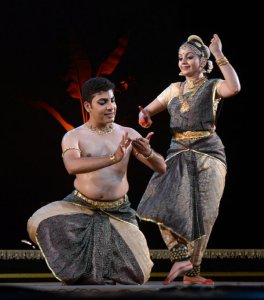 KC Rupesh & Sneha Bhagwat On day two and three, the programs took place at Ravindra Kalakshetra. Day two that featured all Bangalore based artistes started with a Bharatanatyam duet by KC Rupesh (disciple of Chitra Vinod) and Sneha Bhagwat (disciple of Sanjay Shantaram). They had collaborated a couple of years earlier for another festival and are members of the 4 member group Maya. The first item featured pushpanjali choreographed by Chitra Vinod and Ganesha Stuti by Sanjay Shantaram. The second item sung soulfully by Srivatsa was Thyagaraja’s “Naada tanumanisham” in ragam Chittaranjini choreographed by the dancers themselves. The finale was a thillana in raag Bageshree sung by Balasubramania Sharma and Manasi Prasad. One could see the dancers were talented, had boundless energy and they danced in sync with each other, but their adding elements from other dance styles like Kuchipudi and Bharata Nrithyam invited advice from chief guest Prof. MR Krishnamurthy that, “ if you perform one traditional dance form, stick to that and do not mix it with other forms.”  BP Sweekruth and Manasa Joshi Next was a Kathak duet recital by BP Sweekruth and Manasa Joshi. Both are solo artistes who worked together in 2011 and since then have collaborated on special projects. They commenced with vachana of Basaveshwara in praise of Lord Shiva, “Swami neenu shashwatha neenu” sung by Ganesh Desai and choreographed by Sweekruth. The dancers performed well together with good command over footwork. Manasa then presented “Lalita lavanga” a solo choreographed by Guru Maya Rao and sung by Shankar Shanbag. Sweekruth’s Jhap Taal pure nritta solo in cycle of 10 beats to music by Neeraj and choreographed by Maulik Shah and Ishira Parikh was well appreciated by the audience. Madhurashtakam set to music by Asit Desai and sung by Sanjiv Abhyankar depicted episodes from the life of Krishna. It was choreographed by Sweekruth. At times, the lyrics and the corresponding action were ill matched, so in relating words and actions, more planning is needed. The duo completed their recital with a beautiful tarana set to teen taal in raag Bhairavi, a lilting composition by Pt Ravi Shankar. Though the dancers changed costume for every item, none of these were striking and to add to that, it was surprising to see the unshaven appearance of Sweekruth. A smoke machine was placed at the back of the stage in the centre and kept puffing out clouds of smoke at intervals. These would bunch up on top and hover like an atom cloud, looking like colorful cotton candy when lights changed. It added nothing to the attraction, but was only a distraction. 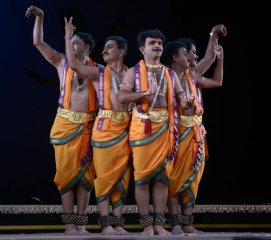 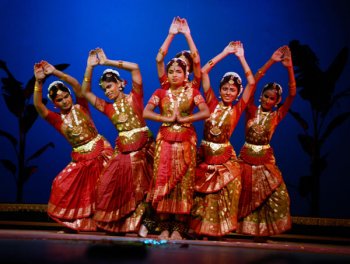 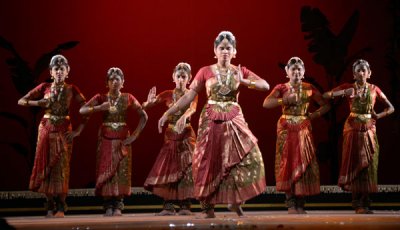 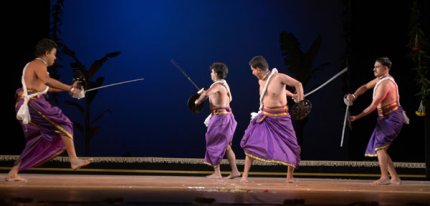
Articulate Ability The finale was a Bharatanatyam presentation by the visually challenged artistes of Articulate Ability featuring 5 males and 6 females – Buse Gowda, Guruprasad, Taraka Ramulu, Satish Rao, Sivaswamy, Suma, Sowmya, Latha Mani, Gulab Shah, Pallavi and Rashmi. They are being trained under the loving guidance of Mysore B Nagaraj and Suparna Venkatesh. In the first item Poorva Ranga Vidhi, the male performers conduct a ritual sprinkling water to sanctify the space and then go around the stage invoking the guardians of the eight directions. The perfect placement of objects, superb coordination and synchronized movements marked this item. They then presented Dwadasha Stotra, an ode to Ganesha extolling the various attributes of the elephant headed god. Faultless crisscrossing of stage and beautifully formed stills earned them spontaneous applause of the appreciative audience. The female dancers then performed an item on Kundalini Shakti. Dancers stood one behind the other, fanned out like a five headed cobra, performed mini solos to a string of jathis, fell back into straight lines or performed in circles in fluent movements and accurate positions. The item on martial art with the male dancers wielding sword and shield was mind boggling in its execution, the performers even clashing swords with each other with precise, geometric moves. The audience could not stop applauding. The girls concluded with a thillana in tribute to the musical instruments used in dance. Felicitating the artistes, dancer Lakshmi Gopalaswamy said, “I performed a thillana with them last October. I thought it would be easy and I did not need much rehearsal but I underestimated their capacity. Just by hearing, they could point out any mistake in my steps. I was fascinated by the way they took their positions and made perfect formations. It was a revelation. I have been so inspired and amazed by them.” Mysore Nagaraj did a good job as the evening’s anchor with clear description of items and regaling us with brief anecdotes about the background of the visually impaired dancers. The organizers could have planned in such a way that the Articulate Ability were featured earlier in the evening rather than the last act as members of the audience started leaving by 9pm. If more performance opportunities come its way, the group will be able to show many other people across the country that visual impairment has not deterred these wonderful artistes from following their passion for dance. As the representative from sponsor Canara Bank said earlier in the evening, learning dance and music is a great stress buster and they would continue to remain committed to supporting the arts.   Sanjay Shantaram, Shivapriya ensemble The final evening of the festival started with a long varnam on Lord Shiva, “Aadum deivam arulvaai” composed by Kameshwaran in Kalyani raagam, performed by Sanjay Shantaram and 14 female students of Shivapriya ensemble. While the ensemble came together for the lively nritta sequences, Sanjay shone in the solo dramatic abhinaya section depicting the story of ‘Bedara Kannappa’ and also in the brief depiction of the argument between Brahma and Vishnu, with Sanjay doing Shiva’s role. The exuberant choreography involved interesting line formations, lots of leaps and twirls with the dancers maintaining their balance.  Priyadarsini Govind
The charged, lively first section of the evening gave way for a calm and composed recital by Priyadarsini Govind. She commenced with an alarippu in Shanmukhapriya, mishra chapu, set against the backdrop of Thirupugazh composed by young dancer Aadith. The vocal and nattuvangam going on side by side in same volume created a bit of conflict to the ears. Next was a varnam “Saami ninne kori naanu ra” in Ragamalika of the Thanjavur Quartet, jathis composed by senior mridangist G Vijayaraghavan. It was relaxing to watch her poised abhinaya and measured nritta sequences done with quiet grace. Due to the time limit, Priya presented two short abhinaya pieces – the sarcasm laden “Indendu vachitivira” in Surutti ragam in which the khandita nayika ticks off her wayward lover and “Apudu manasu” in Khamas ragam in which the coy heroine wonders how it is possible to control the beating of her heart when coming face to face with the man of her dreams. It was a nice contrast of emotions and much appreciated by the audience. Priya was the only performer to have live accompaniment – Jayashree Ramanathan on nattuvangam, Krithika Arvind on vocal, Vedakrishnaram on mridangam and Srilakshmi on violin. 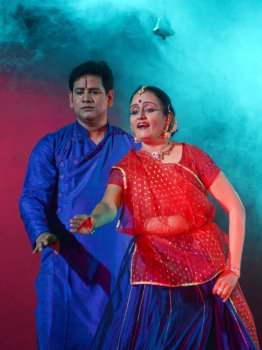 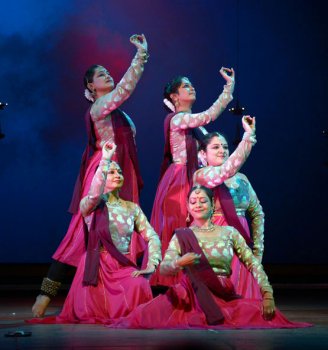 Murali Mohan and Nandini Mehta, Nadam ensemble The grand finale was a super charged Kathak performance by the Nadam ensemble, the most applauded group of the festival apart from Articulate Ability. Murali Mohan and Nandini Mehta presented a Nataraja Stuti followed by Ganesha Stuti performed by the ensemble (Smitha Srinivasan, Arpita Banerjee, Samanvita Sharma, Poorna Acharya and Chandana Ramesh) that received rapturous applause. Next was “Krishna nee begane baaro” composed by Praveen D Rao. While doing the choreography, they felt that Murali doing little Krishna’s role and Nandini playing Yashoda would be unsuitable hence they decided to play the roles of Krishna’s parents who would interact with an imaginary baby Krishna. It seems to have worked since this was the 370th presentation of this item! One could almost sense the presence of Krishna, especially in the end when the father carries him on his back with the mother walking next to them playfully engaging the little boy. The power packed Teen Taal set to a time cycle of 16 beats was a high voltage, foot stamping and twirling ensemble presentation rewarded with frequent bursts of applause. Some audience members even whistled their appreciation. Mysore B Nagaraj and Kaladegula Srinivas were the comperes in English and Kannada respectively. The festival was conducted smoothly and efficiently. Rounding off the celebrations, host Sanjay Shantaram thanked all the sponsors, the special invited guests, the technicians, coordinators and volunteers. He ended by calling his parents on stage and thanking them for their support and instilling in him, the value of simplicity and humility from a young age. The three of them beaming on stage made for an “Awww!” moment! Balancing a career as a film and TV star as well as a dancer, Sanjay Shantaram is to be congratulated for completing 25 years as a dance teacher and as he is all set to continue for many more years, here’s wishing him the very best in his endeavors. Lalitha Venkat is the content editor of www.narthaki.com |